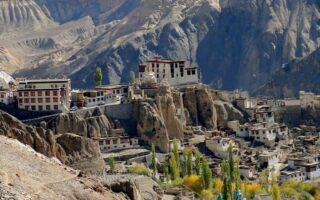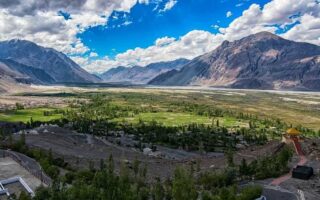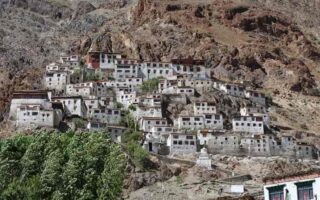The most integral parts of our society are fairs and festivals that bind our family and friend together. It’s a reason to spend time with our near and dear ones with the rich clothes, delicious feast and each festival with its own significance. We have one such region that is embedded with such significance which is known as Leh Ladakh that is situated in north part of India. Decorated with the old culture it also has the beautiful old monasteries, monuments festivals and fairs and many rich art forms.
Ladakh is situated in the centre of the high mountains gives the picturesque view. The monastery of Buddha found here is counted amongst the World’s Heritage Site which constitutes the Buddhist religion and culture. The best part of the culture here is that let it be the saddest demure nut it is celebrated with the great joy and happiness. The Gompas festivals are celebrated in winter. This grand festival is celebrated with the colorful attires and mask wore by monks, adorable dance performance, representing the various aspects for the society i.e. betterment of Human beings, purification of good things over bad.
Tourists from all over the world visit and take part in the fairs and festivals of Ladakh. It grant us a wish to fulfill our desire, meet the old friends, make some new ones, have party and spend good times with the bustled occasion. A very well known monastic festival is Hemis which is celebrated in the month of July by worshipping God Padmasambhava.
The other festivals that are celebrated in Ladakh are Lamayuru in the month of July. Karsha and Phyang are celebrated in Zanskar. The Phyang involves the exhibition of Thankas which can be seen once in a year. The other covers the Stok, Matho, Chemrey, Spituk, the winter festivals mark their beginning from the month of November to March. Deskit and Likir is also celebrated in the winter season with Dosmoche which is one of the well known festivals of Ladakh. All the festivals here are celebrated with the great zest and seal.
New Year Festivals:
Dosmoche and Losar are celebrated in the February marking the most important and the major festivals celebrated in Leh. Dosmoche is a huge wooden platter festooned with the religious emblems and the streamers are hanged outside the Leh. They offer the life of the goat in the belief that the sacrifice of a life will embark a good beginning and end all the bad evils of the previous year.
Losar is celebrated in the Leh region where the entire Buddhist offering to the Deity of Gods. They are offered in the Gompas as well in the Domestic Shrines.
Galdan Namchot Festival
- Where: Ladakh, Tibet, Nepal, Mongolia
- Month of the Festival: December
- Festival Dates for 2022: 18 December
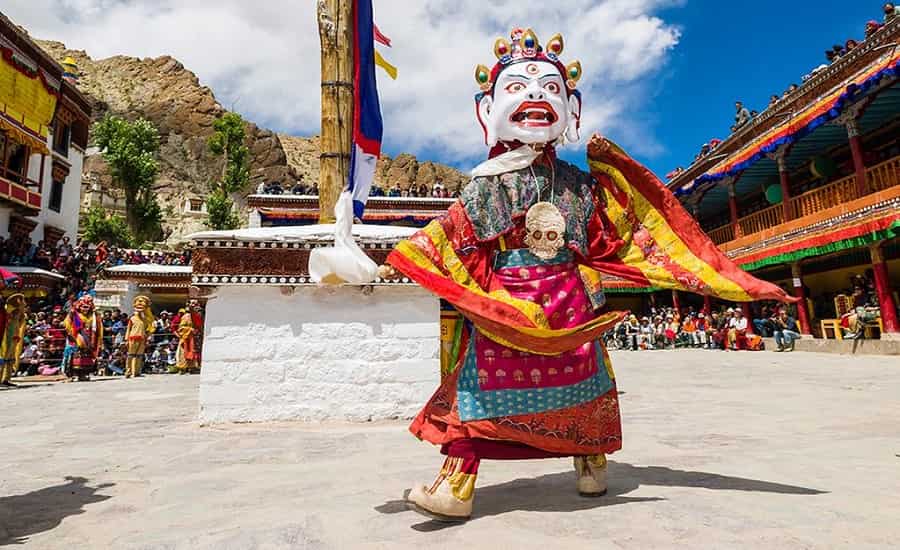
Ladakh says lively and vibrant throughout the year with zestful and colorful festivals giving them respite from the on going tensions of the militants and the hard living conditions. The festivals are mainly dance dramas, which is performed by the Lamas who dress in their colorful traditional suites with masks and robes, perform according to the traditional aspect. One of the famous festival is Galdan Namchot Festival which is celebrated in Ladakh. It is celebrated to mark the birth of Tibetan saint scholar Tsongkhapa. The famous Gelukpa School of the 14th century that prophesied Tibetan Buddhism was founded by Tsongkhapa. This school becomes a dominant and an important part of the Tibetan Buddhism Teaching.
Galdan Namchat Festival is celebrated with great zeal and fervor in Ladakh. This festival is like Diwali in Ladakh as all the residential and public buildings are lit up with colorful lights. This festival observes the beginning of the New Year and is on until the Dosmoche festival. On this joyful event, varieties of traditional dishes are made. Thukpa, the traditional dish is a must. People visit their families and friends, have feast together and enjoy this colorful and bright festival.
Hemis Festival
- Where: Hemis Monastery
- Other Name: Tse-chu
- Festival Dates for 2022: July 8th to July 9th
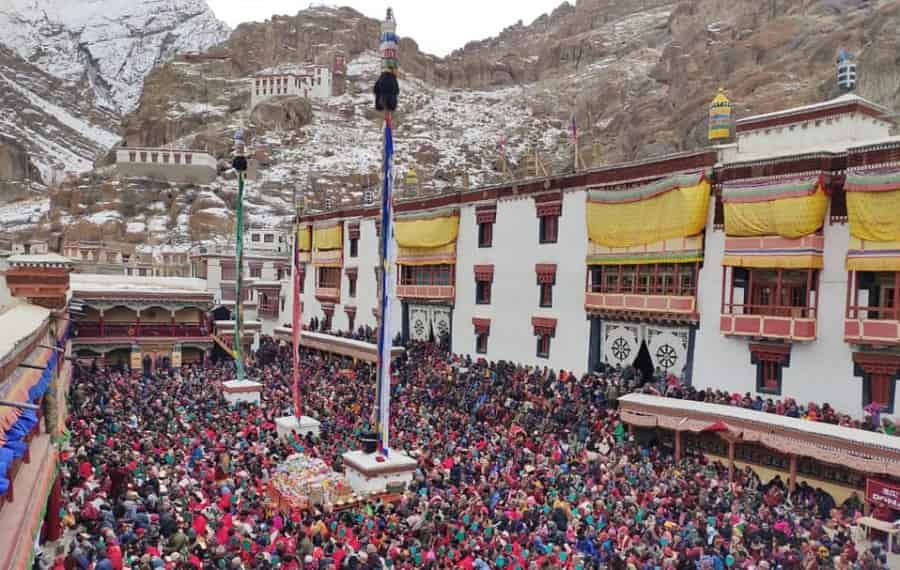
This festival is one of the largest Hemis Festival observed in Ladakh. It is celebrated to mark the birth of Guru Padmasambhava, who according to the mythology fought with the demons to spare the people of this place. This festival marks its beginning on the 10th day of the Tibetan Lunar month, which is also known to be the day of birth of the Padmasambhava (Guru Rimpoche) beginner of Tibetan Buddhism. This is a two-day festival at the Hemis Monastery.
The Monks of the Hemis Monastery performs masked dance, which is considered to be sacred. The masks that are worn by the monks represents different guardian divinities of the (Dugpa order).The leading establishment of this is considered to the Hemis all over Ladakh. The tradition of this festival is about two hundred years old and was introduced by a member of the royal family who was transmigrated in the (18th century) as the monasteries head monk, Sras Rinpoche.
The Hemis dancers are said to be the revered and contributes to the service of Padmasambhava. The guru is said to have seemed in 8 different manifestations. The Hemis Festival imbues every twelve years in the Tibetan Year of the Monkey, when thangka which is a 2 storeyed idol depicting Padmasambhava is shown. This popular Thangka is heavily embroidered with semi precious stones and pearls and is also very brightly colored will be displayed in the year 2016.
This festival is held during the summers, this festival clings on many visitors from Ladakh and outside the province.
Phyang Tsedup Festival
- Where: Phyang Monastery, 17km Westside of Leh
- Festive Season: July to August
- Festival Dates for 2022: 26-27 Jul
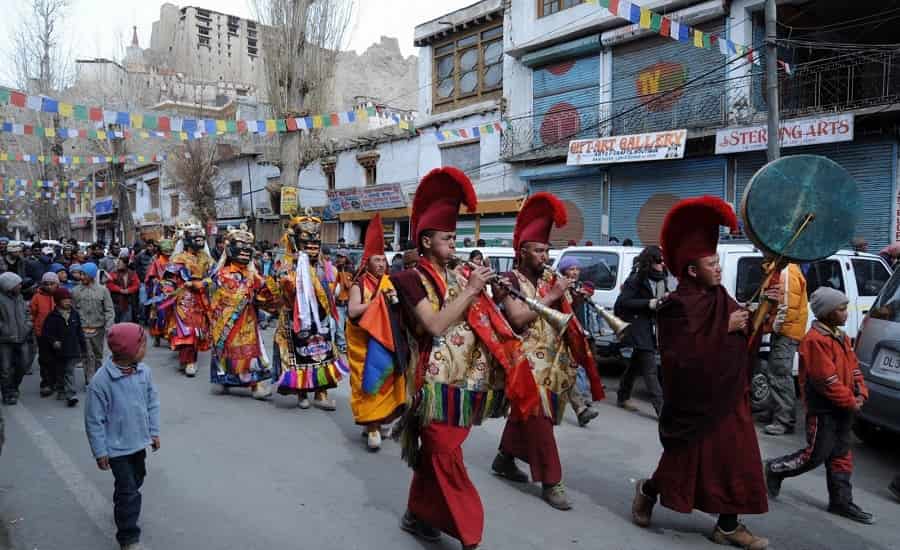
Phyang is the ancient monasteries situated in Dringunpa (Ladakh).The Phyang Tsedup Festival marks its beginning in July to August. During this festival men jam in the monastery, wearing colorful costumes and never ending smile on their innocent face.
The presence of such powerful energies brightens the atmosphere and this festival is celebrated with great pomp’s and joy all around Ladakh. During this festival people not only from India but also abroad pile up on the of Phyang Tsedup Festival to enjoy the vigor and cultural richness.
The beginner of the Dringumpa Monastic Dynasty also with other name (Skyabje Jigten Gombo) was considered to be a saintly person .There is a Thangka which has been constructed in his loving memory; this is the same site where the festival takes place every year.
The Thangka artifacts which are constructed by the Tibetan workers are world renowned and had become popular from during the time of Dalai Lama.
This festival is one of the most colorful and joyous festival in Ladakh .This is a Buddhist festival. The Buddhist Monks participate in Chhams which is a dance drama. The dance drama is the major part of the festival, Thankha of the Jigten Gombo is also worshipped. The Buddhist Monks dresses up in colored attires and play different characters of dance drama.
The most important and cheerful thing of this festival is the mask. The Monks perform the Chhams wearing colorful masks of different idols of Gods. You can visit the exhibition which is held here in two days during the festival of Phyang Tsedup. While the festival is on many Buddhist articles are displayed as to spread Buddhism (teaching of Lord Buddha) to the mankind. The Phyang Tsedup marks its beginning in the month of July to August and usually goes on for 2 days.
Yuru Kabgyat Festival
- Where: Lamayuru Monastery, Leh
- Festive Month: Jun/July
- Duration: Two days
- Festival Dates for 2022: 26-27 Jun
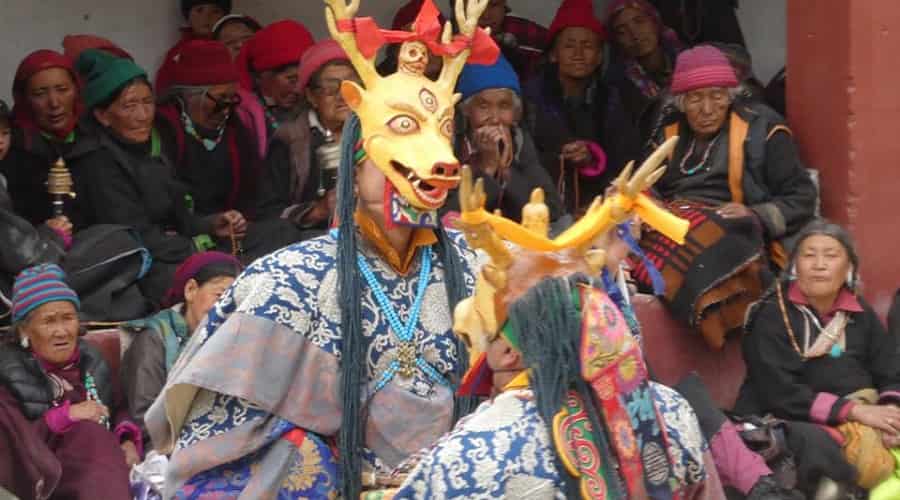
The Yuru Kabgyat Festival is celebrated at Lamayuru, which is located 127 km away from Leh. This festival is on for two days. This festival is attended by many people not only from India but also from other countries. The lamas from countries like Japan, Korea, Tibet, China comes to attend the Yuru Kabgyat festival, Leh. It is a very colorful festival, which is celebrated with great enthusiasm and pomp. Esthetically dressed in colorful attire the Buddhist Lamas concourse the Leh Valley, they also take part in the dance drama.
Mask dances are the inseparable element in the Buddhist Festival as none of the Buddhist Festival is ended without their traditional dance. The Mahayana Tradition is a traditional culture, which is, exists in Bhutan, and the mask dance is a priority. The Holy Scripts of Buddhist Literature mentions that the Mask Dance dates back to the eighth century and Chham was the first dance, which was performed. The overwhelming integration of the Lamas at Spiti, Kinnaur, Ladakh and Lahaul has made the Masked Dance an auspicious and enjoyable experience. The major objective behind this magnificent mask dance is to conciliate the idol. The Mask Dance is also performed to save the Mankind from the deadly epidemics, Natural Calamities, to assure healthy living and hygiene for the humanity and to shoo off the evil spirits.
The dance of the Yuru Kabgyat comprises of Chhams in which the Monks dance, they form a huge circle and wear colorful masks. The huge circle is accompanied by long pipes, cymbals and drum beats. These masks are made up of paper Mache and dilute coat of plaster.
The Idols of Yama (the Lord of Death) and Padmasambhava (the God of Wealth) are worshipped. Padmasambhava is known as the protector of human race, animals and horses. If you want to enjoy the scenic performance of this dance then Lamayuru is the best place, as this popular dance form is held every year on the Yuru Kabgyat Festival. This Festival is marked on the month of July to August and ends with, sacrificial offerings.
Sindhu Darshan Festival
- Where: Banks of the Indus River, Leh
- Festive Month: June
- Festival Dates for 2022: 12-14 Jun
- Importance: This river is known to be one of the largest river of the world
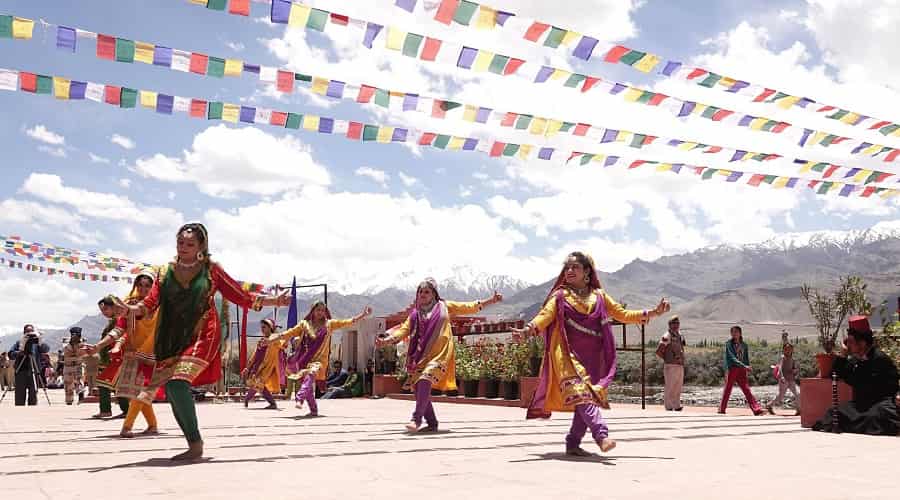
This festival is one of the attractive and colorful festival of North India. Known for its splendor and vibrancy, the Sindhu Darshan Festival is the plume of Ladakh. This festival is held at Ladakh with joy and pomp’s. Leh is the local place for the celebration of this festival. This festival is sort of a carnival where the Indus River is paid homage and the local name of this river is Sindhu. It is believed that India got its name from the river Indus.
Sindhu Darshan in The Hindi language is witnessing of The River Sindhu. It is said that a single glance to this river is very beneficial and fortunate. As a result this river is very popular and round the year people come to see this magnificent river. The Festival begins with the holy dip in the river after that men and women dresses up in good clothes to pay homage to the river .This river is considered to be holy and as a result flowers and fruits are offered to the river by men and women. River Indus is the largest river in India.
It originates in south west part of (Tibet) and makes its entry to India via Leh or Ladakh .This river is so auspicious that its name has been mentioned in the holy books like the Vedas. This Festival is a blend of religious and cultural significance and derives it name from the Sanskrit language. This festival is a process for the soul sanctification. The Tarpan which is to pay homage to the forefathers is offered by the men standing on this river. This to offer water to the soul of our forefathers. There is an ancient belief that if you perform the ritual standing on this river then the soul is released forever from the clutches of the human bondings.
The significance of this river dates back to the old manuscripts and ancient texts. The one who attends this festival is considered to be lucky. While you visit this festival, you will come across varieties of Buddhists Stupas. Lord Buddha had once visited this place with his men so this place is a major significance for the Buddhists as well.
This Festival is held for two days and is a must visit to observe the pure and mighty river.
Stok Guru Tsechu Festival
- Where: Stok monastery
- Festive Month: February to March
- Festival Dates for 2022: 11-12 Mar
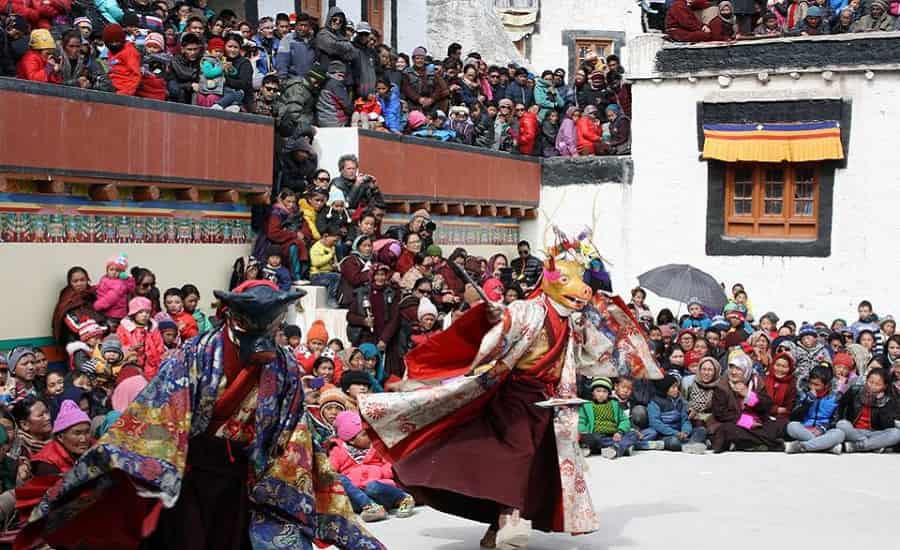
Stok Guru Tsechu Festival is a Buddhist Festival which is celebrated every in the month of (February) a week before Matho Nagrang Festival. This festival is one of the popular festivals celebrated in the entire Ladakh. This festival is celebrated with great gaiety and pomp’s by the Buddhist community all over Leh Ladakh.
The Buddhists Monks of Spituk and Stok monasteries celebrate the festival of Stok Guru Tsechu for 2-days.This festival is observed in the same way as the Matho Nagrang .Also in this festival the 2 oracles makes public appearance , same like the one in Matho Nagrang festival .The only difference between the 2 festivals is that unlike Matho Nagrang where the two oracles make public appearance , in the Stok Guru Tsechu festival common people from the village makes public appearance , these common men are prior prepared by the lamas to conjure the holy spirits and the deity.
This festival is celebrated in the village of Stok, Ladakh. Stok Guru Tsechu Festival is marked in Gurphug, Ladakh dated ninth and tenth days of first month of the Tibetan Lunar Calendar. The festival begins with the dance of the monks, the famous mask dance by the (monks) of the Spituk Monastery, Ladakh.
Matho Nagrang
- Where: Matho Monastery, Ladakh
- Festive Month: February to March
- Festival Dates for 2022: 17-18 Mar
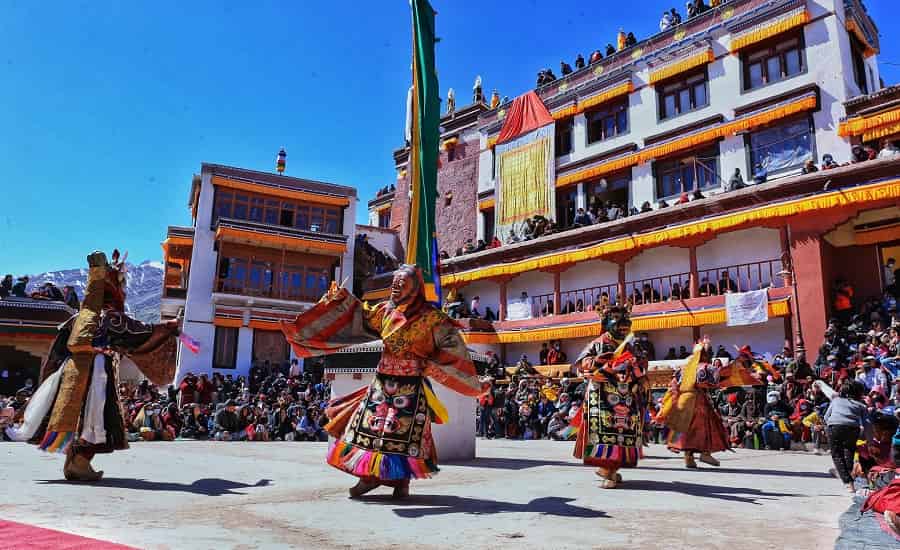
Ladakh is clustered with visitors every year not only because of the lovely picturesque but also for the interesting locals and colorful culture. This region is also known for the old monasteries, one of the most popular monastery is the Monastery of Alchi, which has been declared as the world heritage. Ladakh is also known for the monastery festivals and attracts hoards of visitors during the time of the festivals. Matho Nagrang is one of the famous monastic festivals celebrated in Ladakh.
Matho Nagrang is deemed in the Matho Monastery and is one of the colorful festivals. The mask dance performance by the monks is worth seeing which is conducted in the first 2 days of the festivals. They wear vibrant and colorful silk brocaded attires. The mask which they wear ponders faces of varieties of monastery Goddesses and Gods. The major halt in the festival is the oracles who do meditation for the whole two months appears to the courtyard of the monastery and also joins the mask dancers.
This marks their first public appearance in the two months. According to the locals they have future predicting capacity, so people from far off come here to seek advice from the two oracles and also perform rituals to protect others from unpleasant happenings and other disasters. The oracles come in trance from the isolated meditation. They perform few acrobats completely blindfolding their eyes that includes jumping and running from one balcony to another. These performances are worth watching during this festival.
The Matho Nagrang marks it presence on t5he fifteenth day of the first month of the (Tibetan Calendar).This festival takes place at the Matho Monastery which belongs to the SAKHYA School Of Tibetan Buddhism.
